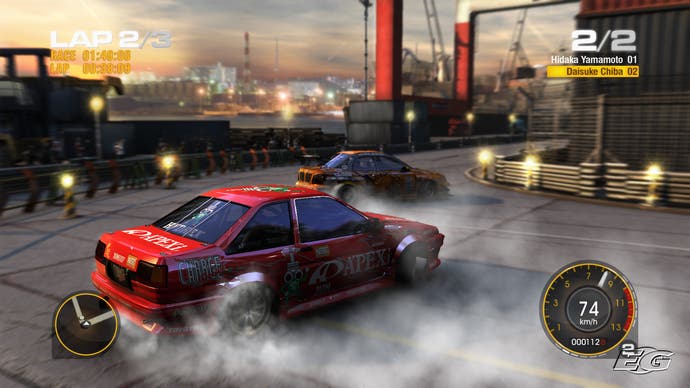Race Driver: GRID
Project go team!
Europe, Milan aside, is all about real race tracks: Castle Donington, the brand-new Istanbul Park, Jarama (a little-known but wonderfully fast and sweeping Spanish circuit), the new F1 track at the Nurburgring (but not the Nordschleife, which is good, because we're almost bored of it now), and Belgium's mighty Spa-Francorchamps, which is the greatest race track in the world - fact. If that weren't enough, the terrifying Le Mans 24-hour race appears under official licence, as a special even at the end of each 'season' of your career. It takes 24 minutes in the game, and is a chance for Codemasters to show off their lovely dynamic time-of-day changes. If you were worried about Race Driver losing its motorsport pedigree with its change of direction, you ought to be feeling a bit better now.
Races sport fields of between twelve and twenty cars - a good sign that the busy tracks we loved in TOCA will return - and a mixture of fictional and real-world racing teams to compete against, including a "boss" team who will be rivals throughout the game. As is Codemasters racing tradition, there's full damage: "I wouldn't like to insinuate that others are too lazy to do it," says Fulton, who feels that licensing issues are too often used as an excuse. "If you're going to do it, you have to do it properly, and I think that's probably a decision that a lot of people don't want to take."
Damage can be deeply frustrating to the player though, as anyone who's crashed on the last lap of a Forza endurance race will know. Hence GRID's most radical and controversial feature: Flashback. It's a one-button rewind (available only in single-player, naturally) that allows you to unspool your crash, similar to the Sands of Time in recent Prince of Persia games. Codemasters is still considering very carefully how to ration use of Flashback (indeed, whether to ration it at all). We hope they get it right, because it will have an enormous impact on the game's balance, and could quite easily make or break it.

The most striking new racing class is a fairly serious recreation of real-world drifting competition, with a simplified version of the scoring system used by the famous D1 championship series in Japan, that judges you on angle, speed and flair. Specific cars with drifting set-ups are used - including many famous D1 vehicles - and they drift easily without using a different handling engine, which was a point of honour for Fulton.
"I don't think it's all that controversial to say it: drift has not been done well in a videogame," he states. "We're kind of battling against gamers' perceptions, particularly those who aren't that aware of what drift is in real life, of drift in videogames as being generally overwhelmingly poor. Traditionally developers do one of two things - go super-simmy and involve things most gamers don't understand, like clutch kicks... or the absolute opposite end of the spectrum where you almost seem to have a completely different physics engine for your drift. We've done neither of those things."
Drifting will come in two flavours, a straightforward score attack, and a racing game that balances position against score. Drifting around the Yokohama docks is certainly hypnotically compelling, the huge slides and ticking score multipliers making it feel like a simultaneously more extravagant and focused version of PGR4's drift kudos challenges.

We also get to try out the DBR9 in Milan, a BMW M5 touring car at Jarama, and a Dodge Challenger in a muscle car race in San Francisco. With all three driving aids (steering, brakes and traction control) turned on, the handling is direct and surprisingly easy-going, with controllable slides. Turning the aids off changes things of course, but not as much as you might think; we weren't expecting Forza's overwhelmingly detailed realism, but the gritty bite of TOCAs of old seems to have been lost in translation somewhere.
There are plenty of compensations, though. The opponent AI is entertaining - aggressive and credibly accident-prone - the physicality that the damage brings to the game is immense, and there's a proper in-car view, too. Surprisingly, GRID finds its best expression in the muscle car class in San Francisco, as the V8 monsters scrape and squabble through wide corners and make camera-wobbling crash landings from jumps. Sitting down with one of the handling engineers later, we spent ten happy laps just chucking the vintage Mustang around, with all driver aids off. The more basic and brutal a car is, the better GRID seems to get. (Which is not to say we aren't looking forward to getting our hands on the just-confirmed Koenigsegg CC GT.)
Concerns about handling depth and the implementation of Flashback aside, Race Driver GRID already looks like a phenomenally well-polished and entertaining game that brings a number of interesting ideas to a crowded genre. Codemasters is one of the best racing developers in the world, and out of all of them it has maybe the clearest sense of what makes for exciting track action. A change in style for the US market doesn't change that, and Codemasters absolutely deserves this shot at playing with the big boys.




.png?width=291&height=164&fit=crop&quality=80&format=jpg&auto=webp)



